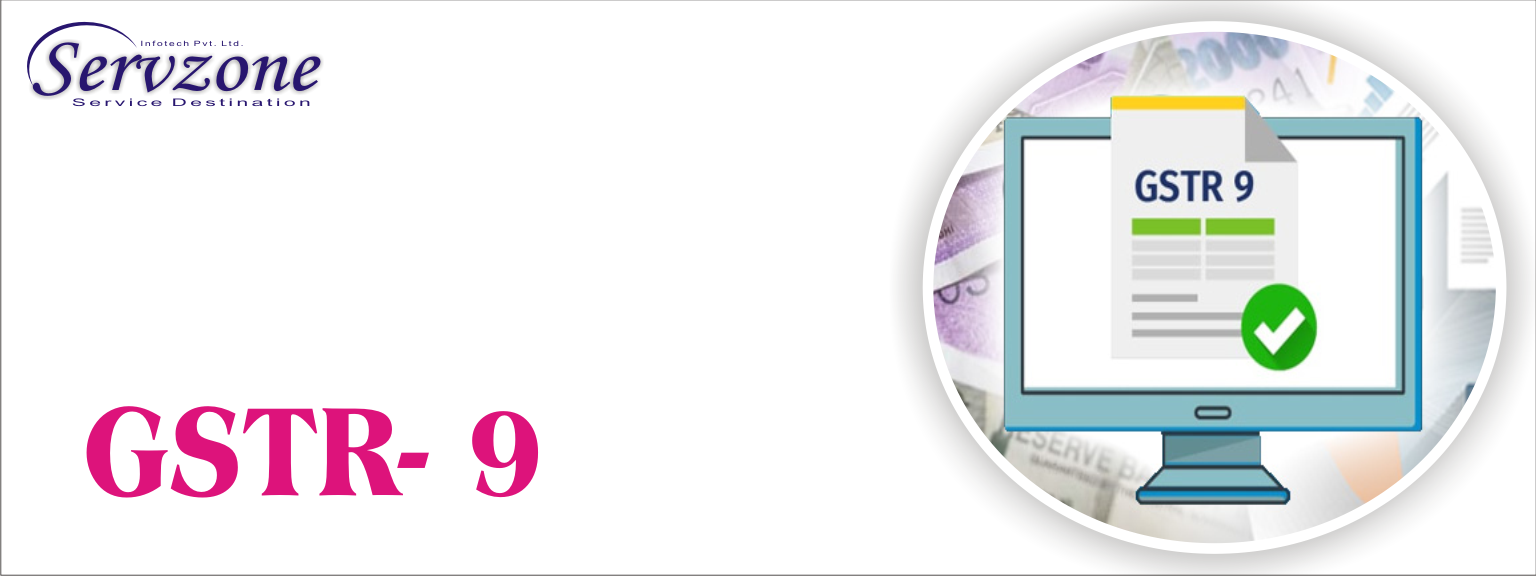Get Started With
servzone
GSTR-9
GSTR-9 is the annual return to be filed by taxpayers registered under GST. It will contain details of all outward supplies made, inward supplies received during the relevant previous year under different tax heads i.e. CGST, SGST & IGST and HSN codes, along with details of taxes payable and paid. It is a consolidation of all the monthly or quarterly returns (GSTR-1, GSTR-2A, GSTR-3B) filed during that year.
GSTR-9 is required to be filed by all taxpayers registered under GST*, except taxpayers who have opted for the Composition Scheme, Casual Taxable Persons, Input Service Distributors, Non-resident Taxable Persons and persons paying TDS under section 51 of CGST Act.
*As per the CBIC notification 47/2019, the annual return under GST for taxpayers having an aggregate turnover which does not exceed Rs.2 crore has been made optional for FY 2017-18 and FY 2018-19.
What is GSTR-9 annual return?
GSTR 9 is an annual return to be filed yearly by taxpayers registered under GST. Points to note:
It consists of details regarding the outward and inward supplies made/received during the relevant previous year under different tax heads i.e. CGST, SGST & IGST and HSN codes.
It is a consolidation of all the monthly/quarterly returns (GSTR-1, GSTR-2A, GSTR-3B) filed in that year. Though complex, this return helps in extensive reconciliation of data for 100% transparent disclosures.
Who should file GSTR-9, the annual return?
All taxpayers/taxable persons registered under GST must file their GSTR 9. However, the following are NOT required to file GSTR 9:
- Taxpayers opting composition scheme (They must file GSTR-9A)
- Casual Taxable Person
- Input service distributors
- Non-resident taxable persons
- Persons paying TDS under section 51 of CGST Act.
GSTR-9 filing for businesses with turnover up to Rs 2 crore made optional for FY 17-18 and FY 18-19*. The CBIC has made GSTR-9 filing optional for FY 2019-20 for small taxpayers whose turnover is up to Rs.2 crores.
*As per the decision taken in 37th GST Council meeting held on 20th September 2019. Subject to the notification.
Due Date, late fee and penalty
The due date to file GSTR-9 is further extended to November 30, 2019.
- The late fees for not filing the GSTR 9 within the due date is Rs 100 per day, per act. That means late fees of Rs 100 under CGST and Rs 100 under SGST will be applicable in case of delay.
- Thus, the total liability is Rs 200 per day of default. This is subject to a maximum of 0.25% of the taxpayer’s turnover in the relevant state or union territory. However, there is no late fee on IGST yet.
What are the details required to be filled in the GSTR-9?
GSTR-9 is divided into 6 parts and 19 sections. Each part asks for details that are easily available from your previously filed returns and books of accounts.
Broadly, this form asks for disclosure of annual sales, bifurcating it between the cases that are subject to tax and not subject to tax.
On the purchase side, the annual value of inward supplies and ITC availed thereon is to be revealed.
Furthermore, these purchases have to be classified as inputs, input services, and capital goods. Details of ITC that needs to be reversed due to ineligibility is to be entered.
- Auto-filling of all tables of GSTR-9 including Tables 6-8, 10, 11 and 17
- A simple 19-point checklist to identify potential errors
- In-built audit trail at an invoice level for each entry
- Directly import the data into MicroTax with the superfast Tally plug-in.
- Auto-compute outward HSN summary from sales books to fill Table-17
- Invoice-level reconciliation of GSTR-1 with books of accounts
- One-click GSTR-9 data upload to GSTN and filing with advanced MicroTax Assistant for GSTR-9
Due Dates of Filing GST Returns
These returns are as per the CGST Act*
|
Return Form |
Description |
Frequency |
Due Date |
|
GSTR-9 |
Annual return for a normal taxpayer. |
Annually |
31st December of next financial year. |


GST Registration

PVT. LTD. Company

Loan

Insurance


